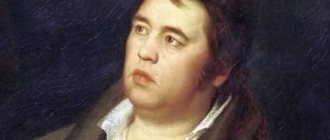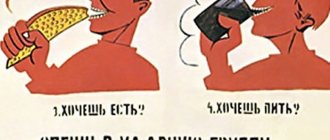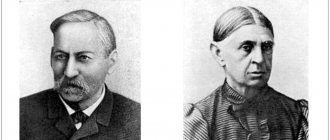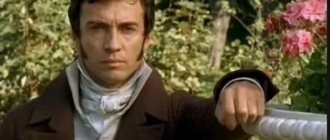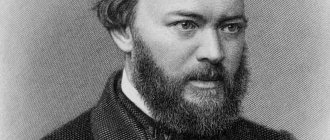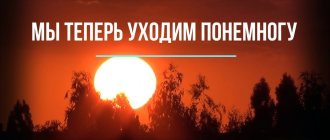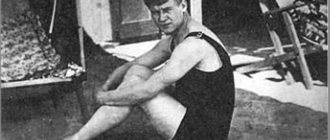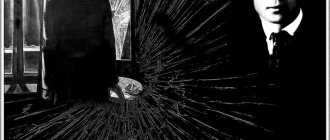Periodization of biography
Sergei Yesenin lived a short but eventful life. The poet's talented nature prompted him to constantly search for himself. He has always been noticed by society due to his charisma and creativity. In order to better understand the poet’s work, we can divide all periods in his life into three specific stages:
- Childhood.
- Youth.
- Maturity.
He wrote his first poems when he was nine years old. Since childhood, a talent from God awakened in him. At a young age he was already writing entire poems. He has published in many publications and read his poems publicly. He was an active participant in many organizations.
The writer's childhood
As a child, the poet learns a lot and begins to write his first poems. It is best to depict Yesenin’s biography in a table in chronological order:
| date | Event |
| 03.10.1895 | The poet was born into a family of peasants. Parents: Yesenin Alexander Nikitich, Titova Tatyana Fedorovna. Place of birth: Ryazan province, village of Konstantinovo. |
| Until 1904 | Sergei spends most of his time with his grandparents. |
| 1904 | He entered the Konstantinovsky Zemstvo School. He studies well, but behaves poorly in class, which is why he was retained for one year again. He begins to compose his first poems about nature and ditties. |
| 1909−1912 | He graduated from college with a certificate of merit. Then he continues his studies at the parochial school in Spas-Klepiki. He studies Russian literature, reads the works of great classics - Lermontov, Pushkin, Gogol. He still writes poetry and reads it in front of an audience. |
Chronological outline of Yesenin’s life and work
Skorokhodov M. V., Yusov N. G., Yushkin Yu. B. Chronological outline of the life and work of Sergei Aleksandrovich Yesenin (1895-1925)// Yesenin S. A. Complete works: In 7 volumes - M.: Nauka; Voice, 1995-2002.
T. 7. Book. 3. Lost and unfound. Unfulfilled plans. Yesenin in photographs. The canvas of life and creativity. Bibliography. Pointers. — M.: Science. — 2002
. — P. 267-354.
Chronological outline of the life and work of Sergei Aleksandrovich Yesenin (1895-1925)
The chronological outline of Yesenin’s life and work is built mainly on the basis of those dates and information that are one way or another reflected in the present volumes. ed. (history of the creation and publication of works of art, correspondence, participation in creative unions, acquaintance with famous cultural figures, etc.). The outline also contains materials of significant interest for the study of the poet’s work and biography, which were discussed in previous volumes. ed. not mentioned. In a number of cases, independent search work was carried out. The chronological outline is published for the first time in such a complete volume and taking into account a number of newly identified and updated information.
Its compilation was made possible thanks to data collected by researchers of Yesenin’s work. The basis of all subsequent Yesenin chronologies is the literary chronicle of V. G. Belousov “Sergei Yesenin” in two parts (M., 1969-1970). New information relating mainly to the poet’s travels was reported by V. V. Bazanov in his “Materials for the biography of S. A. Yesenin” (EiS, pp. 287-341). An important stage in the study of the poet’s life and creative path was the chronicle “Sergei Alexandrovich Yesenin. Main dates of life and creativity,” included in volume 6 of the Collected Works (M., 1980; compiled by V. A. Vdovin). During the preparation of the present. ed. Many dates have been clarified and clarified: the creation and first publications of a number of works, the poet’s public appearances, the publication of Yesenin’s original books and collections with his participation. This is reflected in the present volumes. ed., in the bibliographic reference book by N. G. Yusov “Lifetime publications of S. A. Yesenin” (M., 1994), in a brief chronicle of the poet’s life and work (Rec.-95, pp. 554-565; compiled by S. I. Subbotin and N. I. Shubnikova-Guseva), as well as in individual articles and publications.
The proposed chronological outline gives a holistic picture of the poet’s creative path, his literary contacts, performances and trips. In addition, it takes into account historical and other events that influenced Yesenin’s fate and were reflected in his work. At the same time, the chronological outline is far from the exhaustive completeness of the chronicle, which is primarily explained by the specifics of the present time. ed.
This section is the basis of the “Chronicle of the life and work of S. A. Yesenin”, the preparation of which is carried out by the Institute of World Literature named after. A. M. Gorky RAS. The chronicle will incorporate the entirety of information about the poet collected to date. It will widely use both creative materials and critical and memoir sources.
Section compiled by M. V. Skorokhodov, N. G. Yusov
and
Yu. B. Yushkin.
The compilers thank Gordon McVeigh for providing newly verified materials on the chronicle of Yesenin’s foreign trip (1922-1923) and express gratitude to all colleagues in the preparation of this present. ed. for effective assistance in the work.
September, 21 (October 3, new).
Sergei Aleksandrovich Yesenin was born in the village of Konstantinovo, Kuzminsk volost, Ryazan district, Ryazan province. Father - Alexander Nikitich Yesenin, mother - Tatyana Fedorovna, nee Titova, peasants of the village of Konstantinovo.
September, 24.
Baptized in the Konstantinovskaya Church of the Kazan Icon of the Mother of God.
Lives in the house of his grandmother, Agrafena Pankratievna Yesenina.
1898
Lives in the house of T. F. Yesenina’s parents - Fyodor Andreevich and Natalia Evtikhievna Titov.
Sister Olga was born (died 3/III 1901).
1900
Starts to read.
1903-1904
Makes his first attempts to write poetry, imitating ditties.
1904
September.
He enters the Konstantinovsky Zemstvo four-year school, where he studies for five years.
The end of the year.
Returns with his mother to his father's family.
1905
November 22.
The poet's sister Ekaterina was born.
May (?).
Retained due to bad behavior for the second year in the third grade of the Konstantinovsky Zemstvo four-year school.
1909
May.
He graduates from the Konstantinovsky Zemstvo four-year school with a certificate of merit and receives a certificate of completion of the school.
September.
Successfully passes the entrance exams and begins his studies (until May 1912) at the parochial second-grade teacher's school (the village of Spas-Klepiki, Ryazan province and district). During his studies he lives in Spas-Klepiki, coming to Konstantinovo on vacation.
1910
December, 1.
Writes the poem “The Coming of Spring.”
—2.
Writes the poem "Autumn".
—4.
Writes the poem “Winter”.
—8.
Writes the poem “To Friends.”
During a year.
The beginning of systematic poetic creativity. In 1925, when preparing his collection, the poet dates the poem “It’s already evening” to 1910. Dew...", "Where the cabbage beds are...", "Winter sings and echoes...", "Imitation of a song", "The scarlet light of dawn is woven on the lake...", "The flood is filled with smoke...", "The bird cherry is pouring snow...", " Kaliki."
1911
January, 24.
He writes a poem “As I remember now...”.
—25.
Writes the poem “Sunrise”.
March, 16.
The poet's sister Alexandra was born.
— Writes the poems “Night” (“The river quietly slumbers...”), “To the dead man,” “To a friend,” “Pine and the river.”
June.
The first known letter is to the closest friend of his youth, G. A. Panfilov.
June, end-July, until 7.
He comes to Moscow to visit his father and returns to Konstantinovo.
July, 7.
In a letter to G. A. Panfilov he reports a visit to Moscow and the purchase of books.
October November.
Writes the poem “Stars”.
November, after 17.
In connection with a visit to the school by the diocesan observer of parochial schools in the Ryazan province, I. D. Rudinsky writes a poem dedicated to this event and sketches another work that remains unfinished.
During a year.
In 1925, when preparing his collection of poems, the poet dates back to 1911 “Under the wreath of forest daisies...”, “It’s a dark night, I can’t sleep...”, “Tanyusha was good, there was no more beautiful thing in the village...”.
1912
March, April.
In 1918, when first published, he dates to this time “The Legend of Evpatiy Kolovrat, of Khan Batu, the Flower of the Three Hands, of the Black Idol and Our Savior Jesus Christ.”
April, 26.
Writes a poem “Blizzard on April 26. 1912"
May, after 5.
Sends to Moscow for the competition of lyric poems named after. S. Ya. Nadson, announced by the Society of Periodical Press Workers, his poems (which ones are unknown).
—after 20.
—the end of the month.
He gives G. Panfilov his photograph with the autograph of the poem “Poet” (“Not a poet, who is the words of the prophet ...”).
First half (?) of the year.
He is preparing a collection of poems, “Sick Thoughts.”
July, 8.
Meeting M. Balzamova.
—second decade.
He writes the poem “You cried in the evening silence...” (addressee: M. Balzamova).
-Start of correspondence with M. Balzamova.
—second and third decades.
Attempts to publish a collection of poems “Sick Thoughts” in Ryazan (not published).
—end.
Leaves Konstantinov for Moscow for permanent residence.
August, until 18.
In a letter to G. Panfilov, he talks about his poetic work, sends the recipient the poem “Drops” (“Pearl drops, beautiful drops ...”).
—18.
Registered in Moscow at the address: B. Strochenovsky lane, 24, apt. eleven.
Within a month.
He goes to work in the office of the owner of a butcher shop, merchant N.V. Krylov, where his father A.N. Yesenin works as a clerk.
-Leaves his father and goes to work in the office of the book publishing house “Culture” (Malaya Dmitrovka, 1).
-Informs G. Panfilov of his intention to write the work “The Prophet”.
In a letter to M. Balzamova, he mentions that he “started the drama The Prophet.”
November.
In a letter to G. A. Panfilov he writes about reading the Gospel, the spirit of which is close to the addressee; sends the text of the poem “Sad... Mental anguish...” and an excerpt from the poem “Death” (“Who will tell and reveal to me...”; the full text is unknown).
During a year.
This year in 1925, when preparing his collection, the poet dates the poems “Play, play, little girl, raspberry furs...”, “Mother walked through the forest in a bathing suit...”, “The evening began to smoke, the cat was dozing on a beam...”.
1913
January, 26.
In a letter to M. Balzamova, he reports the completion of work on “The Prophet” (text unknown).
February, 9.
In a letter to M. Balzamova, he cites a poem dedicated to her, “You cried in the evening silence...”.
—second half.
Leaves Moscow for Konstantinovo. Soon returns to Moscow.
February March.
Distributes the Social Democratic magazine “Lights” among workers, intends to be published in this magazine (Yesenin’s works were not published in this publication due to the closure of the magazine).
Spring.
Enters the expedition of the printing house of the I. D. Sytin Partnership (Pyatnitskaya St.).
March, until 16.
Signs a letter from “Five Groups of Conscious Workers of the Zamoskvoretsky District of Moscow” to R.V. Malinovsky, a member of the State Duma from the Social Democratic Party, and collects other signatures under it.
—after 16.
In a letter addressed to G. A. Panfilov, he writes about his mental turning point: “I have changed in
».
May.
Working on the poem “Tosca” (text unknown).
May-December.
Works in the proofreading printing house of the I. D. Sytin Partnership.
June 16.
In a letter to G. A. Panfilov he reports an ongoing conflict with his father.
September, first half.
He meets the poet and translator I. A. Belousov, to whom he reads his poems.
—after 23.
Becomes a first-year student of the historical and philosophical cycle of the academic department of the Moscow City People's University named after A. L. Shanyavsky.
September October.
In letters to G. A. Panfilov he reports a search carried out in his apartment. No documentary evidence of this episode has been found.
September-December.
Makes his first attempts to publish his poems in Moscow periodicals. Perhaps their first publication took place on November 27 (December 10 AD; not identified).
October, end.
In the Moscow security department, in connection with Yesenin’s participation in organizing an illegal meeting of Sytin workers sympathizing with the RSDLP(b), a personal “External Surveillance Journal” was opened: “1913. The observation key is “Set”. Installation: Yesenin Sergey Aleksandrovich, 19 years old.”
November, 1-7.
It is under external surveillance by spies, whose reports are recorded in the specified “Journal”.
December 19.
The Moscow Security Department sends a letter No. 302891 to the Police Department with information about 16 persons who “may be” signatories of the “Letter of Five Groups...”, among them: “Sergey Alexandrovich Yesenin,
peasant of the Ryazan province and district, Kuzminskaya volost, village of Konstantinova, 19 years old, proofreader at the Sytin printing house on Pyatnitskaya street, lives in house No. 24, apartment 11 on Strochenovsky Lane. <…> All these persons had not previously been through the department on business.”
—31.
1914
January.
In the Moscow children's magazine "Mirok" under the pseudonym "Ariston" the poem "Birch" was published - the poet's first known publication.
January March.
Enters into a civil marriage with A. R. Izryadnova.
February, until 25.
In a letter to G. A. Panfilov he says: “I printed out in full Ivanovo. <…> and my pseudonym “Ariston” was removed.”
February, 25.
Death of G. Panfilov.
Within a month.
The magazine "Mirok" publishes the poems "Sparrows" <Winter Sings - Calls...> and "Powder".
-Sends a letter to M. Balzamova, asking to return his letters and photographs, and also to send her photograph.
March, 2.
A.F. Panfilov sends Yesenin a letter informing him of the death of his son, G.A. Panfilov.
Within a month.
The magazine "Mirok" publishes "The Village" - a free translation of an excerpt from T. G. Shevchenko's poem "Princess", on the 100th anniversary of the birth of the Ukrainian poet.
April.
“Mirok” magazine publishes “Easter Good News” <The Slumbering Bell...”>.
May. 15.
The Petrograd Bolshevik newspaper “The Path of Truth” published the poem “The Blacksmith.”
— Leaves work at the printing house of I. D. Sytin.
July 16.
Leaves Moscow for Crimea.
—18.
Arrives in Sevastopol. On the same day he departs by steamship for Yalta.
—August 18, beginning.
Located in Yalta.
—19.
Germany declares war on Russia.
Within a month.
In the magazine "Mirok" there is a poem "Good morning!"
August, until 10.
Returns from Crimea to Moscow.
August-December.
He responds to the war with the works “Mother’s Prayer”, “Heroic Whistle”, “Jackdaws” (the text of the last work has not been found). Writes the poem “Martha the Posadnitsa”.
September.
Enters the printing house of the trading house “D. Chernyshev and N. Kobelkov.”
October.
The magazine "Protalinka" published the poem "Mother's Prayer."
November 23.
The Nov newspaper publishes the poem “The Heroic Whistle.”
December, 21.
Within a month.
In “Mirka” there is a poem “The Orphan (Russian Fairy Tale)”.
-Leaves work at the printing house.
Late 1914-early 1915.
Writes the poem "Rus".
-Submits an application to become a full member of the Surikov Literary and Musical Circle.
During a year.
This year in 1925, when preparing his collection, the poet dates the poems “The reeds rustled over the backwater ...”, “Trinity morning, morning canon ...”, “Beloved land! The heart dreams...”, “The Lord came to torture people in love...”, “Autumn”, “It is not the winds that shower the forests...”, “In the hut”, “Through the village along a crooked path...”, “Go you, Rus', my dear...” , “I am a shepherd, my chambers...”, “Is this my side, my side...”, “The melted clay is drying up...”, “I smell God’s rainbow...”, “Mantises are walking along the road...”, “You are my abandoned land...”, “ The drought drowned out the seeding...", "Black, then smelly howl...", "Swamps and swamps...".
1915
January, 1.
The magazine "Friend of the People" publishes "Patterns".
—16.
In the manuscript registration book of the editorial office of the Petrograd Monthly Journal, the receipt of the poem “Evening” <“On azure fabrics...”> was noted (it was not published in this journal).
—21.
Sends the first letter to A.V. Shiryaevets, which served as the beginning of many years of communication between the two poets.
Within a month.
"Mirok" publishes the poem "What is this?"; magazine "Mars" - poem "Belgium".
January-February, beginning.
On a voluntary basis, he is the secretary of the magazine of the Surikov literary and musical circle “Friend of the People”. Participates in the preparation of his second issue.
January February.
Reads “Rus” to members of the Surikov literary and musical circle.
February, 2.
— 7.
Participates in a meeting of the editorial commission of the Surikov literary and musical circle, expressing strong disagreement with the principles of selecting materials for the magazine “Friend of the People” proposed by the leadership of the circle.
—8.
Submits an application to leave the circle.
—22.
The magazine "Women's Life" publishes "Yaroslavnas are crying" - the first of the famous articles on literary topics.
Within a month.
The Moscow magazine “Milky Way” publishes the poem “Kruchina” <“The reeds rustled over the backwater…”>; the magazine "Ognivo" under the general title "Two Sonnets" - "Greece" and "Poland"; Kazan magazine “Life” - poem “To My Princess”.
-The Moscow magazine “Red Laughter” publishes in the “Mailbox” section the quatrain “You burn, my lightning…” <excerpt from the poem “Dare”, sent by the poet to the editor of the magazine>.
March, 8.
Leaves Moscow for Petrograd.
—9.
Upon arrival in Petrograd, he meets with A. A. Blok at his apartment, reads his poems, and receives letters of recommendation to S. M. Gorodetsky and M. P. Murashev. A. A. Blok inscribes Yesenin’s book of his poems.
—11.
Meets with S. M. Gorodetsky and reads his poems to him. Receives from him letters of recommendation to the editor-publisher of the “Monthly Magazine” V. S. Mirolyubov and the secretary of the magazine “Dushevnoe Slovo” S. F. Librovich.
—12.
The receipt of the poem “Jackdaws” (text unknown) is noted in the “Monthly Journal” manuscript registration book.
—15.
Reads poetry in the salon of D. S. Merezhkovsky and Z. N. Gippius. Meets the literary critic and publicist D. V. Filosofov and the writer A. P. Chapygin.
—28.
Present at the evening “Poets for Warriors” in the Army and Navy Hall (Kirochnaya St., 1). Meets the poets V. S. Chernyavsky and M. A. Struve.
—29.
He writes the poem “I will dress you as a beggar...”, dedicated to R. Ivnev.
—30.
Reads poetry in the editorial office of the New Magazine for Everyone.
Within a month.
The Milky Way magazine publishes the poem “The scarlet light of dawn was woven on the lake...”; “Cheryomukha” is published in Mirka.
March, April.
Makes acquaintances in the literary circles of Petrograd (A. A. Dobrovolsky (A. Trishatov), A. K. Boane, V. A. Rozhdestvensky, O. Snegina, A. M. Remizov, F. K. Sologub, L. I. Kannegiser, Rurik Ivnev, L. M. Dobronravov, S. I. Chatskina, Ya. L. Saker, K. Yu. Lyandau, etc.).
-The Moscow magazine “Parus” publishes the poem “O child, I cried for a long time over your fate...”.
The Petgrad magazine “Sincere Word” publishes the poem “Bird Cherry” for the second time.
—before 18.
“New Magazine for Everyone” re-prints “Kruchina” <“The reeds rustled over the backwater…”> (this time with a dedication to S. M. Gorodetsky).
—18.
Visits A. M. and S. P. Remizov. He leaves in the writer’s family autographs of the poems “The evening is smoking, the cat is dozing on a beam...”, “Kaliki” and the poem “Rus”.
—22.
Receives a letter of recommendation from S. M. Gorodetsky to the editor of the newspaper “Birzhevye Vedomosti” M. M. Gakkebush.
—22.
“The Petrograd magazine “Voice of Life” publishes four poems: “Guslyar” <“It’s a dark night, I can’t sleep...”>, “Mantises” <“Mantises are walking along the road...”>, “In the hut”, “Fisherman”, < “Under a wreath of forest daisies...”>, accompanied by an article by Z. Gippius (under the pseudonym R. Arensky) “Earth and Stone.”
-A. A. Blok writes a letter to Yesenin.
—24.
Sends a letter to N.A. Klyuev, which marked the beginning of many years of communication between the two poets.
-Sends a letter to the Remizovs, in which, in particular, he reports his impressions of the writer’s stories he read.
-In a letter to M. Balzamova, he reports on his immediate plans: trips to Moscow, Konstantinovo and Ryazan (regarding conscription into the army).
—25.
The Moscow magazine “Good Morning” publishes “Beggar”.
-Visits the editorial office of the magazine “Lukomorye” and receives 24 rubles “as a fee.”
—27.
The receipt of the poem “Bachelorette Party” is noted in the “Monthly Magazine” manuscript registration book.
—29.
Leaves Petrograd for Moscow.
-Yesenin’s name is named among the authors of “Voice of Life” on the cover of the magazine.
—30.
Arrives in Moscow.
May, 1.
He writes the poem “The evening is smoking, the cat is dozing on a beam...” into the album of the writer I.V. Repin.
—1.
“Kruchiny” (“The reeds rustled over the backwater…”) both in the Milky Way magazine and in the New Magazine for Everyone.
-Leaves Moscow for Konstantinovo and arrives home on the same day.
—2.
—11.
Sends a letter to the secretary of the “New Journal for Everyone” A. A. Dobrovolsky (A. Trishatov).
Within a month.
“New Magazine for Everyone” publishes an excerpt from “Rus”
May-September.
Lives in the village of Konstantinovo, visits Ryazan, Solotcha and surrounding villages.
June, 4.
S. M. Gorodetsky in a letter to Yesenin informs about the upcoming publications of his poems, asks to send the manuscript of the book “Radunitsa” (?).
— Replies to V. S. Chernyavsky’s letter dated May 26; reports two completed stories and several poems, citing one of them - “I am a wretched wanderer...” <“I am a wretched wanderer...”>.
Within a month.
"Monthly Magazine" publishes the poems "Trinity" <Trinity morning, morning canon...>, "The bird cherry is pouring snow...", "Bachelorette party".
July 18.
"Rus" in the magazine "Northern Notes".
—22.
In a letter to V.S. Chernyavsky he reports his successful publications in the capital and his intention to come to Petrograd in the fall.
-N. A. Klyuev, in a letter to V. S. Mirolyubov, sympathetically evaluates Yesenin’s poems published in the June issue of the Monthly Magazine.
—25.
The Petrograd magazine “Russian Thought” publishes the poems “Monk” <“I will go to skufya as a humble monk...”>, “Kaliki”, “Evening” <On azure fabrics...”>.
—26.
The magazine "Ogonyok" publishes the poem "Recruits" <"Through the village along a crooked path...">.
V. S. Mirolyubov turns to Yesenin with a request to send poems for the Monthly Magazine.
August, 7.
—until 20.
"Mikolu."
—21.
D. V. Filosofov, in a reply letter to Yesenin, informs about sending the poem “Mikola” to the editor of “Birzhevye Vedomosti” for publication.
—22.
D. V. Filosofov sends the works of Yesenin sent to him to the editor of Birzhevye Vedomosti M. M. Gakkebusch.
—25.
"Birzhevye Vedomosti" publishes "Mikola".
Within a month.
“Northern Notes” publishes the poem “Rus”, “Monthly Journal” publishes the poems “Shepherd” <I am a shepherd, my chambers...”> and “The scarlet light of dawn is woven on the lake...”.
-N. A. Klyuev, in a letter to Yesenin, gives the young poet advice regarding communication with representatives of Petrograd literary circles.
September, 1.
In the book of registration of manuscripts of the "Monthly Journal" the receipt of the poem "White Scroll and Scarlet Sash..." is noted.
—6.
N.A. Klyuev, in a letter to Yesenin, reports his desire to perform in Petrograd with a joint reading of poetry on military topics.
—16.
"Monthly Magazine" on behalf of V. S. Mirolyubov sends Yesenin a notice about the upcoming publication of his poems in the magazine and asks him to send folk tales and old songs.
—up to 30.
On his way from Konstantinov to Petrograd he stops in Moscow.
—30.
Meets with the poetess L.N. Stolitsa, who inscribes her book “Rus” to Yesenin.
October, 1.
“Native land, troparion from the calendar…” <“Beloved land! The heart dreams...">.
—2 or 3.
Comes from Moscow to Petrograd. First meeting with N. A. Klyuev.
—6.
Together with N. A. Klyuev, he visits the critic A. A. Izmailov, as well as the poet, translator and bibliographer F. F. Fiedler.
—7.
— He is writing his first autobiography, “Sergei Yesenin.”
—10.
In the letter, F. F. Fidler asks to re-send the “Questionnaire” for the upcoming book of autobiographies of writers.
-Present at the deliberative meeting of the literary and artistic society "Strada", held at the apartment of S. M. Gorodetsky (Petrograd, Malaya Posadskaya, 14, apt. 8).
—11.
“Birzheveye Vedomosti” prints “Howl” <Black, then smelling howl!...”>.
—17.
"Strada", whose chairman was I. I. Yasinsky.
—21.
Together with N.A. Klyuev, he visits A.A. Blok.
-Reads poetry in the editorial office of the Monthly Magazine.
—22.
Sends a letter to L.N. Capital, in which, in particular, he informs about plans for his public appearances.
—23.
S. M. Gorodetsky writes a letter of recommendation to the editor of the Petrograd branch of the newspaper “Russian Word” A. V. Rumanov, in which he asks for Yesenin’s help in publishing his book “Radunitsa” in the publishing house I. D. Sytin and speaks highly of the work of the young poet.
—25.
“Beauty” in the concert hall of the Tenishevsky School.
-In the “Birzhevye Vedomosti” there is a poem “Scarlet darkness in the heavenly mob...”.
October December.
New acquaintances in the literary and artistic circles of Petrograd (M. Gorky, P. I. Karpov, Ivanov-Razumnik, E. I. Zamyatin, G. D. Grebenshchikov, L. M. Reisner, K. S. Petrov-Vodkin, etc. .).
-Presented to persons close to the highest circles of Russian society - singer N.V. Plevitskaya, patron of the Feodorovsky Sovereign Cathedral in Tsarskoe Selo, Colonel D.N. Loman, and others.
The activities of the Krasa group are ceased.
—14.
“Birzhevye Vedomosti” publishes the poem “Go you, my dear Rus'!..” <“Go you, my dear Rus'...”>.
—16.
He writes a sales pitch to M.V. Averyanov for the publication of the book “Radunitsa”.
—19.
Performs with a reading of poetry at the first evening of the literary and artistic society "Strada" in the hall of the Association of Civil Engineers (Serpukhovskaya, 10).
—22.
“Birzhevye Vedomosti” publishes the poem “The clouds do not melt with a stormy wind...” <“It is not the winds that shower the forests...”>.
—29.
The Ekaterinodar newspaper “Kubanskaya Mysl” publishes “Dancer”; in the same issue there is an article by P. A. Kuzko “About poets from the people,” which speaks warmly about Yesenin’s poetry.
Within a month.
“Monthly Magazine” publishes “Tanyusha” <Tanyusha was good, there was no more beautiful person in the village...”>.
November, second half-December.
"Dawn".
November December.
“Northern Notes” in an advertisement for subscriptions for 1916 names Yesenin’s name among the magazine’s participants.
December, 6.
In the Petrograd newspapers “Rech” and “Day” A. M. Remizov publishes in his adaptation of the fairy tales “Kalennye Chervonetsy”, “Nikolin Thrown”, “The Thief's Candle”, communicated to him by Yesenin.
— In a letter to Ivanov-Razumnik, he lists the places of his publications and asks for a loan from the Literary Fund.
—10.
Evening of the Strada society, dedicated to the work of Yesenin and N. A. Klyuev. A report on the work of poets is given by I. I. Yasinsky.
—13.
"Birzhevye Vedomosti" publishes the poem "In lunar lace furtively...".
—17.
The Petrograd magazine "The Whole World" publishes the poem "The Witch".
—21.
—25.
In the “Birzhevye Vedomosti” there is a poem “Native Land. The fields are like saints..." <"Beloved land! The heart dreams...">.
-In the “Birzhevye Vedomosti” the name of Yesenin is noted among the authors who published their works in 1915.
-Visits A. A. Akhmatova and N. S. Gumilyov in Tsarskoe Selo (Malaya St., 63). Akhmatova inscribes Yesenin’s magazine copy of the poem “Near the Sea,” Gumilyov inscribes the collection “Alien Sky.”
—the end of the month.
Literary and popular-scientific supplements to the magazine “Niva” print a selection called “Rus”: “Is it my side, side ...”, “I’m weaving a wreath for you alone ...” <“Rus”>, “Were carried away by a stray bird ...”.
Winter 1915-1916
Visits I.E. Repin on his estate Penates, reads poetry. Meets the artist Yu. P. Annenkov.
| 1 Conditional abbreviations |
Forward
The poet's youth
In his youth, Sergei Yesenin published his works for the first time. At this time, he settled in Moscow and spent most of his time in a circle of like-minded people. You can summarize in detail the main events of youth in Yesenin’s chronological table:
| date | Event |
| 1912 | Moving to Moscow. He got a job in a printing house as an assistant to a proofreader, thanks to which he read a lot of books and became a member of the Surikov literary and musical circle. |
| 1913 | He met Anna Izryadnova at the printing house, who later became his wife. Enters the Faculty of History and Philosophy at the Shanyavsky University in Moscow. |
| 1914 | He abandoned his studies and work and immersed himself in writing poems. He publishes poems in the magazine "mirok". Published in other newspapers in January. |
| 12/21/1914 | Son Yuri is born. In 1937 he was shot. |
| 1915 | Moving to Petrograd and meeting Klyuev, Gippius, Merezhkovsky and Blok. Accepted into the group of “new peasant poets”. A collection of poems “Radunitsa” is being published. |
| 1916 | Conscripted into the army. In the spring he was invited to read poetry for the empress, which became his salvation from the front. |
Mature years
The poet lived a very stormy and amazing life. He was unlucky in his personal life; all his marriages were unsuccessful. In his life there were six civil and official marriages with famous women:
- Anna Izryadnova.
- Zinaida Reich.
- Galina Benislavskaya.
- Isadora Duncan.
- Nadezhda Volpin.
- Sofia Tolstaya.
He loved to take a walk and drink well, which is why he was even forced to undergo treatment in a psychoneurological clinic. At the same time, he remained a talented poet, whose work is unforgettable to this day.
All the main dates of adulthood can be listed in chronological order in the table:
| date | Event |
| 1917 | Married Reich Zinaida. They have a daughter, Tatyana, and a son, Konstantin. |
| 1918 | Separates from Reich and moves to Moscow. Publishes the second book of poems “Dove”, then “Transfiguration”. |
| 1919 | Becomes one of the curators of the organization of image artists. |
| 1920 | He lives together with translator Nadezhda Volpin, their son Alexander is born. Works on the poems “Song of the Great March”, “Soviet Rus'”, “Departing Rus'”, “Anna Snegina”, “Black Man”, “Pugachev”, “Land of Scoundrels”. Publishes a collection of poems “Moscow Tavern”. |
| 1921 | Travels through Central Asia, the Urals and visits the Orenburg region. Meets the famous dancer Isadora Duncan. |
| 1922 | Marriage to a dancer. |
| 1922−1923 | Together with Duncan they travel around Europe and the United States. After returning, their marriage breaks up. |
| 1924−1925 | Refuses imagism and leaves for Transcaucasia. Publishes the collections “Letter to a Woman”, “Persian Motives”, “Letter to Mother”, “Stanzas” |
| 1925 | Marriage to Leo Tolstoy's granddaughter Sophia, but the marriage was unsuccessful. He becomes an opponent of Jewish settlement, for which he is accused of anti-Semitism. He gets sick often and drinks a lot. From Moscow he moves to Leningrad, where he checks into the Angleterre Hotel. On the night of December 28, he is found dead in his room; the cause of death remains unknown. |
Many facts about Yesenin’s death remained unknown. At first a version of suicide was put forward, then they said that it was a premeditated murder. Before this, he wrote the poem "Goodbye, my friend, goodbye...", so he may have known that he would soon die. Yesenin had enough enemies. He was also disadvantageous to the authorities because of his poetry. Nevertheless, this great man remained in the hearts of many people thanks to his creativity.
Chronological table of Yesenin
The presented material is a collection of important dates in Yesenin’s biography. Convenient both for academic research and for replenishing personal knowledge, Yesenin’s biography in the table will become an indispensable assistant for every lover of Russian poetry. Childhood, the formation and development of the poet, the last years of his life - Yesenin’s entire life and work are described here. Briefly, perhaps everyone is familiar with the fate of this classic: his poems have not left indifferent several generations of readers. Now a complete and meaningful chronological table of Yesenin is available for study on our website.
1895, September 21 (October 4) - Sergei Yesenin was born.
1904 - Yesenin is sent to study at the Konstantinovsky Zemstvo School, and then to the church-teachers school in the city of Spas-Klepiki.
1912 – Yesenin moved to Moscow.
1913, autumn - Meeting Anna Romanovna Izryadnova.
1914, December 21 – Birth of Sergei Yesenin’s first son, Yuri.
1914 – First publication of poems in the newspaper “Nov” and the magazines “Parus”, “Zarya”.
1915, spring - Yesenin moves to Petrograd, where he meets N.A. Klyuev, Z.N. Gippius, D.S. Merezhkovsky, A.A. Block.
1916 – The first collection of poems “Radunitsa”.
1916 – Yesenin is drafted into the army.
1917, spring - Meeting Zinaida Reich.
1918 – The second book of Yesenin’s poems “Dove” is published in Petrograd, then “Transfiguration”.
1919 – Yesenin turns out to be one of the organizers and leaders of a new literary group - the Imagists.
1920 – Meet Nadezhda Volpin.
1920 – Poems “Departing Rus'”, “Song of the Great March”, “Soviet Rus'”, “Black Man”; dramatic poems “Pugachev” and “Land of Scoundrels”.
1920 – A collection of poems “Moscow Tavern” is being published.
1920, September 19 – Meeting with Galina Benislavskaya.
1921, October 3 – Meeting Isadora Duncan.
1922 – Yesenin and Duncan got married.
1922-1923 – Yesenin and Isadora are making a long trip around Western Europe and the USA.
1923 - They separated.
1924-1925 – Yesenin travels through Transcaucasia;
The collection “Persian Motifs”, the poems “Departing Rus'”, “Letter to a Woman”, “Letter to a Mother”, “Stanzas”, “Anna Snegina”, are published.
1925 – Meeting Sofia Tolstoy.
1925, September 18 - Yesenin and Sofya Andreevna Tolstaya got married.
1925, December 27 - Yesenin writes his last poem “Goodbye, my friend, goodbye...”.
1925, December 28 - at the Angleterre Hotel, Sergei Yesenin was killed by special services, staging a suicide.
September's most popular resources for your classroom:
Characteristics and image of Kabanikha in the play “The Thunderstorm”
Summary of “Smoke”
Summary of “The Golden Key or the Adventures of Pinocchio”
Analysis of the poem “Motherland” by Bunin
The main characters of "Taras Bulba"
"Nevsky Prospekt" very brief summary
Analysis of “Dark Alleys” Bunin
Essay “Causes of conflicts between fathers and children”
Characteristics of Epikhodov from “The Cherry Orchard”
Summary of “Little Tragedies”
